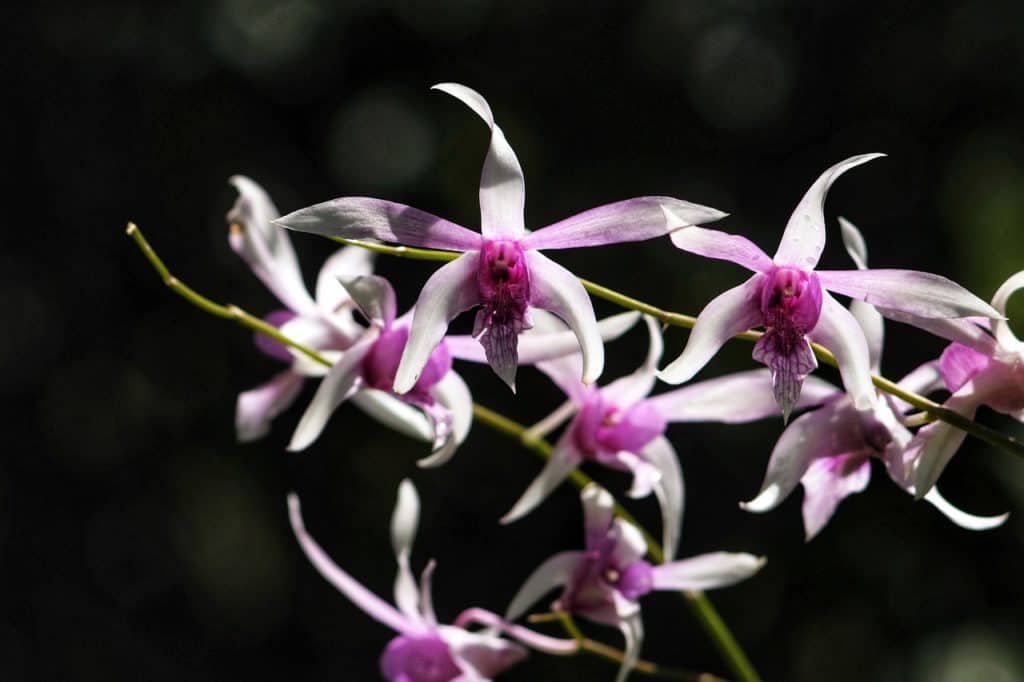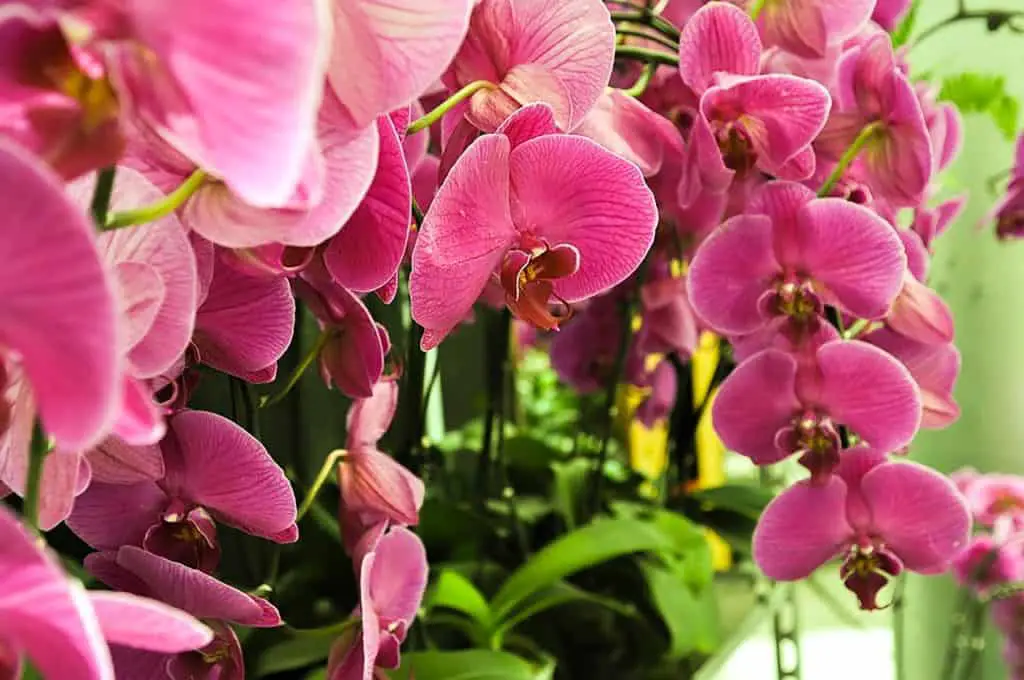The Orchid Life Cycle
In addition to their interesting life cycle, orchids have a number of twists that make them unique among flowering plants. For instance, certain orchids produce a pheromone that attracts female wasps to pollinate them. In this way, male wasps attract the female wasps to pollinate the flowers. It has also been discovered that some orchids are capable of self-pollinating. We are going to discuss the fascinating aspects of the orchid life cycle and the orchid reproduction process in this section. There are a variety of habitats in which the orchid is able to grow, and we will also discuss that.

The Orchid growth habit
Orchids grow either sympodially or monopodially.
Sympodial orchids refer to those orchid plants that receive new growth from lateral shoots. An orchid with monopodial growth habits is one with a stem that grows each year from the apex.
Most of the known orchid species exhibit sympodial growth habits. This growth habit results in thick, bulb-like structures also known as pseudobulbs. In addition to storing moisture and nutrients, these pseudobulbs commonly grow along the orchid’s rhizomes. A common species of orchid with sympodial growth habits is Cymbidium orchid, which produces pseudobulbs with cylindrical shapes almost as if they were growing in a line, since the rhizome acts as a thread that ties the pseudobulbs together.
As well, Bulbophylum orchids grow pseudobulbs approximately three to four cm apart along their rhizome.
Orchid flowers, stems, and leaves develop from the new growth of the pseudobulb. A new bulb will form along the rhizome, and new growth will emerge from the bulb. Once its job is completed, the existing pseudobulb will become dormant and turn into a back bulb. Once the new growth has reached the back bulb phase, it will continue to utilize the last energy reserves stored there. At that point, the back bulb will shrivel up and die.
Not all sympodial orchids develop pseudobulbs.
There are many species of Paphiopedilum orchids that will grow strong shoots from their base. Particularly true for species of Paphiopedilum that grow in humid environments. New growth will emerge from the existing base when the leaves and shoots die. Roots are thick and fleshy, storing moisture in abundance.
Unlike the sympodial growth habit of orchids, the monopodial growth habit enables them to reach incredible heights. Some Vanda orchid species can reach several meters in height. There are no pseudobulbs on monopodial orchids. New growth will develop from the end bud of an old growth, and along the new growth will appear leaves and flowers. Because there are no pseudobulbs, the new growth is supported by succulent leaves which provide nutrients and moisture for the new growth.
There are a number of different habitats where orchids can grow, including marshes and wetlands, trees, the ground, piles of organic matter decomposing, etc. There are three main groups of orchids, namely: epiphytes, lithophytes, and terrestrials. It is also possible for orchids to switch habitats based on the circumstances in which they find themselves. For example, an orchid plant that grows near the base of a tree may grow on its trunk, becoming an epiphyte. Occasionally, orchids will grow on rocks if the conditions are right and there is sufficient moisture and nutrients for growth.
Epiphytic orchids
The majority of orchid species, including the most beautiful specimens, grow in subtropical and tropical regions. Typically, they grow on host trees supported by the trunk and thick branches of those trees. It is not uncommon for them to perch on small twigs at the very top of the tree canopy. Root systems are very strongly developed in all epiphytes that cling to hosts. To sustain themselves, these roots use the moisture and organic material trapped in the crevices and bark of host plants. The humid tropical air provides all of the additional moisture and nutrients required. In itself, this shows the vital role that air movement plays in epiphytic orchids.
Likewise, epiphytic orchids make use of the microclimates offered by their hosts. Many epiphytic orchids prefer shade or moderate dappled light and will grow on the trunks or lower branches of the host tree, while those that are most effective in direct sunlight and require more ventilation will grow in the canopy at the top of the tree. The three most notable epiphytic orchid species are Oncidium orchids, Miltonia orchids, and Cattleya orchids.
Terrestrial orchids
From bogs to forests, sand dunes to semi-arid desert soil, these orchids are able to thrive in very diverse environments. Depending on the situation, terrestrial orchid roots can produce tubers that are just below the soil surface or buried deeper in the soil. In some cases, the plants store nutrients and moisture in these tubers that will enable them to survive times of total dryness. In the winter, terrestrial orchids’ leaves and flowers typically fade away, and they remain underground until the new growth season begins. Upon new growth appearing, there will be a single leafy stem with flowers at the top. Plants of the terrestrial orchid can grow singly or in clumps containing several hundred plants. Among semi-terrestrial orchids there are Cymbidium orchids, Paphiopedilum orchids, and Calanthe orchids. Stenoglottis, Disa uniflora, Bartholina, and Satyrium, which have underground tubers and/or rhizomes, are some examples of terrestrial orchids.
Lithophytic orchids
Most lithophytic orchid species are found in tropical regions. In some cases, they can be found growing on high outcrops. These plants have strong roots that actively absorb moisture and nutrients from the air, and all additional resources that they need are harvested from the rock crevices amongst the moss and organic debris that accumulates in these crevices. In general, you will find that the leaves of lithophytic orchids are very fleshy, and the pseudobulbs are also very succulent to help carry the plant through prolonged dry spells.

The Orchid Life Cycle
Orchids exhibit a similar life cycle to conventional flowers: the seed is produced, it is germination, it develops into seedlings, it matures into plants, it flowers and reproduces.
A chemical reaction is set into motion by pollination, the first step of the orchid’s life cycle. In response to this chemical reaction, the orchid begins its reproduction cycle. When the orchid flower starts to wilt, the sepals and petals begin to shrivel and die. The process sounds pretty typical, doesn’t it? Nevertheless, orchids have very distinct life cycles. It can take an orchid anywhere from nine (9) to fourteen (14) months to complete a full life cycle after pollination.
Among all the features of orchids, prolific seed formation is common. The seeds of orchid species can take some time to mature however, depending on their species. It can take up to twelve (12) months for Cymbidium orchids and Cattleya orchids’ seeds to mature.
Because most orchid species are epiphytic, certain adaptations to their habitat are needed to ensure the species’ survival in nature. In the case of a heavy seed, for instance, it will drop, fall and land on the ground. A bad thing considering it is epiphytic. Instead, feather-light, tiny, delicate seeds could be evolved here, which are easy to airborne and thus have a better chance of landing on hospitable spots.
However, terrestrial orchids require specific soil conditions, so they must disperse more seeds in order to adapt to their natural habitat and increase their chances of survival. The amount of seeds produced and dispersed will seem like a waste, but only a small percentage of seeds land in an environment conducive to growth.
Another way orchid plants differ from conventional flowering plants is the absence of endosperm in their seeds. During germination, orchid seeds require a fungus. The fungus acts as the endosperm by providing the required energy. The mycorrhiza fungus is required for orchids to complete their reproduction cycle.
The orchid reproduction cycle: form, fragrance, and function
Many orchid flowers emit fragrances. Depending on the variety of orchid flower, the fragrance can range from sweet, chocolaty, even musky to stinky, putrid, or acrid. The goal of this wide range of orchid fragrances is to attract specific kinds of pollinators. An orchid’s lip contains special glands that are responsible for producing these fragrances.
Aside from its usual floral color, the orchid also adapts its fragrance release due to the different photo-sensitive and activity levels of its pollinators. Because bees are most active in the morning, it makes little sense for the orchid flower to produce its fragrance throughout the day and attract bees. As a result, this specific orchid, which requires bees for pollination, is fragrance-free at night.
Alternatively, you have orchids that depend on moths for pollination. The orchid flower is relatively unfragranced during the day, but when moths are active at night, the fragrance intensifies. Most pollinating insects are shortsighted, with some having specialized eyesight. Fragrances and scents are therefore ideal to entice them.
There are even orchids that mimic the pollinating agents they wish to attract. Some orchid species are even capable of mimicking and attracting specific pollinating agents with their fragrance, color, and structure.
Ophrys sphegodes deserves special mention among the three adaptations here for being the most spectacular. It is an amazing orchid that creates an excellent imitation of a type of female bee. This specific species of bee impersonated hatches its males a few weeks before its females. When Ophrys sphegodes blooms, its bloom coincides exactly with this period. As a result, the Ophrys sphegodes provides a possible target for male bees actively seeking female mates. Therefore, the poor male bees are tricked into copulating with the Ophrys sphegodes flower. Pollination is affected when these bees pseudocopulate with the orchid flower.
